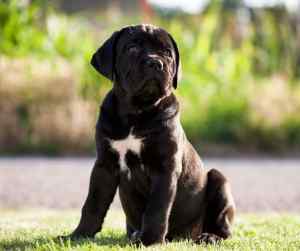Imagine the sheer joy a magnificent (and huge!) Great Dane dog would bring to residents of a seniors home or patients at a children’s hospital. Have you ever wondered about Great Dane therapy dog training? Is it even a thing?
Training your Great Dane to be a therapy dog can actually be an incredibly rewarding journey for both you and your gentle giant. Great Danes are known for their calm demeanor and friendly nature, making them excellent candidates for therapy work.
Below, you’ll find a comprehensive guide to help you through different stages of training, from puppyhood to your Great Dane becoming a certified therapy dog!
Potty Training Your Great Dane Puppy
Obviously, potty training is one of the first and most crucial steps in training your Great Dane puppy. Start by establishing a regular schedule for feeding and potty breaks.
Since Great Danes are giant breed dogs, they can be a bit slower to mature, which means patience and consistency are key. Take your puppy outside to the same spot each time and reward them with treats and lots of praise immediately after they eliminate.
If accidents happen, don’t scold! Act like it didn’t even happen, and clean the pee up thoroughly to remove any scent markers that might encourage your puppy to return to that spot. Using a crate during potty training can also help to prevent accidents in the house, as dogs naturally try to avoid soiling their sleeping area.
Your Dane puppy will get the hang of it relatively soon, and in the meantime, a very absorbent carton of paper towels will be your best friend.
Socializing Your Great Dane Puppy
 Socialization is critical for any therapy dog, as they must be comfortable and calm in various environments. Great Danes must be extra calm, since their overbearing size alone is enough to scare people inexperienced in the ways of these sweet and gentle dogs.
Socialization is critical for any therapy dog, as they must be comfortable and calm in various environments. Great Danes must be extra calm, since their overbearing size alone is enough to scare people inexperienced in the ways of these sweet and gentle dogs.
Begin socializing your Great Dane as early as possible by exposing them to different people, other dogs, cats, animals, (indoor and outdoor) noises, and lots of different environments. Regular walks in the park, visits to pet-friendly stores, and puppy socialization classes are great ways to introduce your puppy to the world around them.
Positive experiences during these formative months will help your Great Dane grow into a well-adjusted adult capable of handling the diverse settings they will encounter as a therapy dog, so encourage well behaved children (and adults) to interact with your dog, treat in hand.
Basic Obedience Training
Basic dog obedience training lays the foundation for any therapy dog. Start with simple commands such as “sit,” “stay,” “come,” and “down.” Great Danes are intelligent but sometimes stubborn, so use positive reinforcement techniques such as dog training treats and high praise to encourage good behavior.
As your dog masters these more simple commands, you can begin to introduce more complex tasks and commands that are essential in therapy settings, such as “leave it” or “quiet.” You can even go further and teach your dog a few simple tricks that will WOW your therapy audience in days to come.
Leash Training
Since Great Danes are so large, leash training is essential to ensure that they can be controlled in a gentle manner. Begin leash training in a quiet environment to minimize distractions. Use a sturdy harness that fits well to distribute pressure evenly and avoid injury.
Teach your Great Dane to walk beside you without pulling, using treats as motivation. Remember, patience is key, as Great Danes can be strong and occasionally stubborn.
House-Training an Adult Great Dane
House-training an adult Great Dane involves much the same patience and consistency as training a puppy but might require some additional steps if the dog has developed bad habits.
Establish a strict routine, with regular feeding times and frequent, scheduled outings for bathroom breaks. Use command words like “bathroom” or “potty” to create associations. Reward successes and handle accidents calmly without punishment. If problems persist, consider seeking the help of a professional trainer.
Frequently Asked Questions About Great Dane Training
- How long does it take to train a Great Dane as a therapy dog?
- It can take anywhere from several months to over a year, depending on the dog’s age, temperament, and prior training.
- Can Great Danes work as therapy dogs in environments with small children or the elderly?
- Absolutely. Great Danes are often known as “gentle giants” and can be excellent therapy dogs in environments with children and the elderly, provided they have been properly trained and socialized.
- What are some common challenges in training Great Danes?
- Due to their size, managing physical strength and stubbornness can be challenging. Additionally, they can be sensitive, so positive reinforcement is crucial.
Further Reading
Here are three valuable online resources for more information on training your Great Dane:
- The Great Dane Club of America
- American Kennel Club – Great Danes
- The Gentle Giant Rescue and Rehabilitation
Conclusion
Training a Great Dane to be a therapy dog requires dedication, patience, and consistent positive reinforcement. These gentle giants have the potential to bring joy and comfort to so many people, so the effort is truly worthwhile. You’ll gain a real sense of purpose and fulfilment from therapy work with your dog – particularly if you are retired.
Thank you for reading, and be sure to check out other articles on our dog training section for more tips and tricks on training your beloved canine.
